- info@wildlife-removal.com
Call us for help in your town
Wildlife Removal Education
Pest Wildlife Animal Information
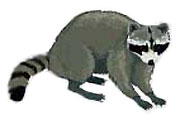 RACCOON: (Procyon lotor) This common nuisance species is very intelligent, curious, and physically capable - strong, and a good climber. Raccoons frequently break into
houses and attics, both in search of food and shelter. They'll also steal pet food, poop in your pool, and get into all sorts of mischief. Adults range from 10 lbs on up, with some reaching over 40lbs. They can live up to
12 years in the wild, though average life spans average closer to 5-6 years. Raccoons mate in the winter, around December, and the females give birth to an average of 3-5 young. Raccoons are omnivores, which means that they
eat both meat and plant matter, and they have a varied diet. They live in a variety of habitats, but the highest populations are actually in developed suburban or urban areas.
RACCOON: (Procyon lotor) This common nuisance species is very intelligent, curious, and physically capable - strong, and a good climber. Raccoons frequently break into
houses and attics, both in search of food and shelter. They'll also steal pet food, poop in your pool, and get into all sorts of mischief. Adults range from 10 lbs on up, with some reaching over 40lbs. They can live up to
12 years in the wild, though average life spans average closer to 5-6 years. Raccoons mate in the winter, around December, and the females give birth to an average of 3-5 young. Raccoons are omnivores, which means that they
eat both meat and plant matter, and they have a varied diet. They live in a variety of habitats, but the highest populations are actually in developed suburban or urban areas.
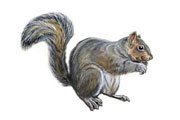 EASTERN GRAY SQUIRREL: (Sciurus carolinensis) Squirrels love to live in attics. Adults average about one pound in weight. They can supposedly live for up to ten years,
but life expectancy in the wild probably isn't more than 3-4 years. Squirrels give birth to two litters per year - one in late summer, and one in winter. The female gives birth to 3-4 young after a 44 day gestation, and
the young grow quickly, and are weaned in about ten weeks. Squirrels are most active in morning and evening. Squirrels eat mostly nuts and seeds. They live in a variety of habitats, both forest and suburban or city areas.
EASTERN GRAY SQUIRREL: (Sciurus carolinensis) Squirrels love to live in attics. Adults average about one pound in weight. They can supposedly live for up to ten years,
but life expectancy in the wild probably isn't more than 3-4 years. Squirrels give birth to two litters per year - one in late summer, and one in winter. The female gives birth to 3-4 young after a 44 day gestation, and
the young grow quickly, and are weaned in about ten weeks. Squirrels are most active in morning and evening. Squirrels eat mostly nuts and seeds. They live in a variety of habitats, both forest and suburban or city areas.
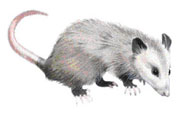 OPOSSUM: (Didelphis virginiana) Possums are nomadic and opportunistic animals. They sometimes establish a home base, especially a female with young, and often live
in human structures. Adults average 10-14 lbs. They don't live very long, rarely more than two years, three max. They mate in January, and then the tiny young climb into the pouch (opossums are marsupials) and grow, then
cling to the mother's back, then leave. Opossums are omnivores, which means that they eat anything. They are nocturnal. They have the most teeth of any mammal (50), a prehensile tail, opposable thumbs, the male has
a bifurcated penis, and they have incredible immune systems.
OPOSSUM: (Didelphis virginiana) Possums are nomadic and opportunistic animals. They sometimes establish a home base, especially a female with young, and often live
in human structures. Adults average 10-14 lbs. They don't live very long, rarely more than two years, three max. They mate in January, and then the tiny young climb into the pouch (opossums are marsupials) and grow, then
cling to the mother's back, then leave. Opossums are omnivores, which means that they eat anything. They are nocturnal. They have the most teeth of any mammal (50), a prehensile tail, opposable thumbs, the male has
a bifurcated penis, and they have incredible immune systems.
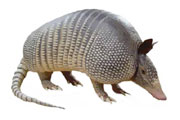 NINE BANDED ARMADILLO: (Dasypus novemcinctus) Dillos cause problems by digging. They are nocturnal animals, and they burrow under the ground to sleep during the day. They
forage at night, and dig up worms and grubs. Adults average 12-16 pounds, and while they can live up to 15 years, many are victims of automobile deaths. Reproduction is interesting - they copulate missionary style, they
mate in summer but delay fertilization until November, and in March, after a 120 day gestation, give birth to four identical quadruplets. Another interesting fact is that Armadillos can carry the human form of leprosy.
NINE BANDED ARMADILLO: (Dasypus novemcinctus) Dillos cause problems by digging. They are nocturnal animals, and they burrow under the ground to sleep during the day. They
forage at night, and dig up worms and grubs. Adults average 12-16 pounds, and while they can live up to 15 years, many are victims of automobile deaths. Reproduction is interesting - they copulate missionary style, they
mate in summer but delay fertilization until November, and in March, after a 120 day gestation, give birth to four identical quadruplets. Another interesting fact is that Armadillos can carry the human form of leprosy.
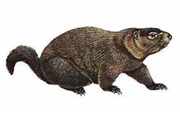 GROUNDHOG (WOODCHUCK): (Marmota monax) Groundhogs also cause problems by digging. They dig larger burrows and more complex labrynths than the simple hole of the armadillo.
Groundhogs are rodents, and adults average 8-10 pounds. They give birth in spring to 3-6 young. They can live up to six years in the wild. They are primarily herbivorous, eating a wide variety of plants. They grow fat during
the summer, lethargic by autumn, and in winter, they hibernate. They are excellent at predicting the arrival of spring.
GROUNDHOG (WOODCHUCK): (Marmota monax) Groundhogs also cause problems by digging. They dig larger burrows and more complex labrynths than the simple hole of the armadillo.
Groundhogs are rodents, and adults average 8-10 pounds. They give birth in spring to 3-6 young. They can live up to six years in the wild. They are primarily herbivorous, eating a wide variety of plants. They grow fat during
the summer, lethargic by autumn, and in winter, they hibernate. They are excellent at predicting the arrival of spring.
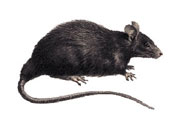 ROOF RAT: (Rattus rattus) and Norway Rat (Rattus norvegicus) The Roof Rat is also known as the Black Rat, the Ship Rat, the House Rat, and the Fruit Rat. This is one of the two major nuisance rat species in the world.
The Norway Rat is also called the Brown Rat. The Roof Rat is the smaller of the two. Adults usually weigh 6-10 oz. with a body of 8 inches and a tail of 8 inches. The Norways are heaver, ranging
from 10-16 oz, with a 9 inch body. Neither lives very long, rarely more than a year in the wild, with a 95% first year mortality rate. They can breed year-round, and produce litters of up to ten young up to five times per
year. Both are omnivores, and will eat a wide variety of foods, but prefer grains. The Roof Rats tend to live in warmer areas, and the Norways in colder climates. Roof Rats spend much of their time living above ground,
whereas the Norways live at ground level.
ROOF RAT: (Rattus rattus) and Norway Rat (Rattus norvegicus) The Roof Rat is also known as the Black Rat, the Ship Rat, the House Rat, and the Fruit Rat. This is one of the two major nuisance rat species in the world.
The Norway Rat is also called the Brown Rat. The Roof Rat is the smaller of the two. Adults usually weigh 6-10 oz. with a body of 8 inches and a tail of 8 inches. The Norways are heaver, ranging
from 10-16 oz, with a 9 inch body. Neither lives very long, rarely more than a year in the wild, with a 95% first year mortality rate. They can breed year-round, and produce litters of up to ten young up to five times per
year. Both are omnivores, and will eat a wide variety of foods, but prefer grains. The Roof Rats tend to live in warmer areas, and the Norways in colder climates. Roof Rats spend much of their time living above ground,
whereas the Norways live at ground level.
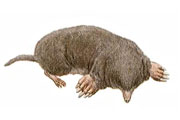 EASTERN MOLE: (Scalopus aquaticus) Several species of moles inhabit North America and are considered a pest species, but the Eastern Mole is one of the most common. All
moles are subterranian - they live under ground - and dig a network of tunnels and chambers. They create surface tunnels and dirt mounds under the chamber areas. The Eastern Mole is small, weighing only about 3 oz. and
is about 6 inches long. They live for about 2-3 years. They breed in January, and after a 45 day pregnancy, give birth to 2-4 young. Most moles are territorial, so there might just be one in your yard. They primarily
eat earthworms, and also other underground larvae and insects.
EASTERN MOLE: (Scalopus aquaticus) Several species of moles inhabit North America and are considered a pest species, but the Eastern Mole is one of the most common. All
moles are subterranian - they live under ground - and dig a network of tunnels and chambers. They create surface tunnels and dirt mounds under the chamber areas. The Eastern Mole is small, weighing only about 3 oz. and
is about 6 inches long. They live for about 2-3 years. They breed in January, and after a 45 day pregnancy, give birth to 2-4 young. Most moles are territorial, so there might just be one in your yard. They primarily
eat earthworms, and also other underground larvae and insects.
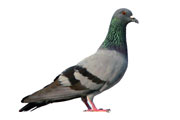 PIGEON: (Columba livia) Often referred to as feral pigeons. These birds are very common in urban areas, and a common city pest. They roost on architecture, such as the
ledges of buildings, beams, store signs, and other such areas. They create a mess with their nesting material and feathers, but most of all, with their droppings, which are unsanitary, unsightly, and which may pose a health
hazard. Pigeons average about 12 inches from head to tail, and weigh about a pound. They tend to live for 3-5 years in the wild. They nest at any time of the year, and mate for life. The young hatch 19 days after the
eggs are laid. Pigeons eat a variety of foods, but prefer seeds.
PIGEON: (Columba livia) Often referred to as feral pigeons. These birds are very common in urban areas, and a common city pest. They roost on architecture, such as the
ledges of buildings, beams, store signs, and other such areas. They create a mess with their nesting material and feathers, but most of all, with their droppings, which are unsanitary, unsightly, and which may pose a health
hazard. Pigeons average about 12 inches from head to tail, and weigh about a pound. They tend to live for 3-5 years in the wild. They nest at any time of the year, and mate for life. The young hatch 19 days after the
eggs are laid. Pigeons eat a variety of foods, but prefer seeds.
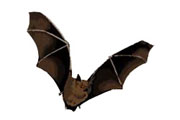 BATS: North America is home to many species of bats, but these are the three most common nuisance (colonizing) species in the US: First is the Little
Brown Bat (Myotis lucifugus) which is common in most of the US, especially the more northward states. These bats are small, with a wingspan of 8 inches, and a weight of less than half an ounce. The females form
large maternity colonies, often in buildings such as attics or barns. Young are born in June, and can fly by August. They can live up to 30 years apparently, though average lifespan in the wild may be about 7 years.
They hibernate in the winter. The Big Brown Bat (Eptesicus fuscus) is also common in the northern areas. It has a wingspan up to 13 inches, and can live up to 19 years in the wild. They mate in October,
before winter hibernation, and after a delayed fertilization and a 60 day gestation, give birth to one or two baby bats in early June. The Mexican Free-Tail Bat Tadarida brasiliensis is common in the south.
It has a wingspan of about 8 inches, a weight of half an ounce, and can live up to 16 years. These bats will form huge colonies, up to several million members in some cases. They mate in the fall, but delay fertilization,
and one pup is born in early June, and can fly about eight weeks later. All of these bats often roost in man-made buildings, and love the attics of homes. None of these animals are actually blind, but they do use echolocation
in order to aid in navigation on the wing. They are all insectivorous, catching insects on the wing.
BATS: North America is home to many species of bats, but these are the three most common nuisance (colonizing) species in the US: First is the Little
Brown Bat (Myotis lucifugus) which is common in most of the US, especially the more northward states. These bats are small, with a wingspan of 8 inches, and a weight of less than half an ounce. The females form
large maternity colonies, often in buildings such as attics or barns. Young are born in June, and can fly by August. They can live up to 30 years apparently, though average lifespan in the wild may be about 7 years.
They hibernate in the winter. The Big Brown Bat (Eptesicus fuscus) is also common in the northern areas. It has a wingspan up to 13 inches, and can live up to 19 years in the wild. They mate in October,
before winter hibernation, and after a delayed fertilization and a 60 day gestation, give birth to one or two baby bats in early June. The Mexican Free-Tail Bat Tadarida brasiliensis is common in the south.
It has a wingspan of about 8 inches, a weight of half an ounce, and can live up to 16 years. These bats will form huge colonies, up to several million members in some cases. They mate in the fall, but delay fertilization,
and one pup is born in early June, and can fly about eight weeks later. All of these bats often roost in man-made buildings, and love the attics of homes. None of these animals are actually blind, but they do use echolocation
in order to aid in navigation on the wing. They are all insectivorous, catching insects on the wing.
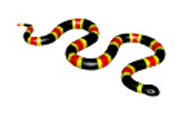 SNAKES: There's too many snake species to catalogue here. The important thing to know is that most snakes are non-venomous, and pretty much none of them are aggressive. That is,
no snake will slither up to you and attack you. Most will run, and some will stand their ground, but if you leave the snake alone, it'll leave you alone. That's how it works for most animals. Some facts common to all snakes -
they have no eyelids. They smell with their tongues, by flicking the forked tongue out and tasting the air with the Jacobsen's organ. They are carnivorous. Some give birth to live young, but most lay eggs. One myth about
snakes is that if a snake has a triangular head, it is poisonous (venomous). This is not true - most snakes have triangular heads.
SNAKES: There's too many snake species to catalogue here. The important thing to know is that most snakes are non-venomous, and pretty much none of them are aggressive. That is,
no snake will slither up to you and attack you. Most will run, and some will stand their ground, but if you leave the snake alone, it'll leave you alone. That's how it works for most animals. Some facts common to all snakes -
they have no eyelids. They smell with their tongues, by flicking the forked tongue out and tasting the air with the Jacobsen's organ. They are carnivorous. Some give birth to live young, but most lay eggs. One myth about
snakes is that if a snake has a triangular head, it is poisonous (venomous). This is not true - most snakes have triangular heads.
I also have information on several other animals. Click any below animal for more info:
Stray Dog Removal -
Pigeon Removal -
Canada Goose Removal -
Starling Removal -
Muscovy Duck -
Woodpecker Removal -
Chipmunk Removal -
Deer Removal -
Flying Squirrel Removal -
Gopher Removal -
Feral Hog Removal -
Muskrat Removal -
Otter Removal -
Porcupine Removal -
Rabbit Removal -
Vole Removal -
Weasel Removal -
Alligator Removal -
Iguana Removal
How to get squirrels out of the attic
How to get raccoons out of the attic
How to get rid of raccoons in the attic
Birmingham Animal Control - Phoenix Animal Control - Tucson Animal Control - Los Angeles Animal Control - San Diego Animal Control - San Jose Animal Control - Sacramento Animal Control - Denver Animal Control - Hartford Animal Control - Orlando Animal Control - Miami Animal Control - Jacksonville Animal Control - Tampa Animal Control - Atlanta Animal Control - Chicago Animal Control - Indianapolis Animal Control - Baltimore Animal Control - Boston Animal Control - Detroit Animal Control - Minneapolis Animal Control - Nassau County Animal Control - Syracuse Animal Control - Charlotte Animal Control - Raleigh Animal Control - Columbus Animal Control - Cincinnati Animal Control - Akron Animal Control - Portland Animal Control - Philadelphia Animal Control - Pittsburgh Animal Control - Houston Animal Control - San Antonio Animal Control - Austin Animal Control - Seattle Animal Control - Milwaukee Animal Control
Animals in a tile roof
- photos of raccoon poop
- photos of possum poop
- photos of rat poop
- photos of squirrel poop
Here are some of the topics I cover on this website. You can click some of them: Possum in attic,
traps for mice,
how to get rid of the odor of a dead rat,
critter and rodent control,
mice attic control,
dead rodent removal ,
how to remove mice from an attic,
getting squirrels from attic,
wildlife photos,
squirrels in attic or wall,
how to get rid of the smell of a dead rat,
snake poop ,
attic insulation replacement ,
florida roof rat,
ways to trap a raccoon,
possum removal from attic,
squirrell in attic,
removing squirrels from attic,
critter burrows in lawn,
how to kill rats in the attic.
Animals in the attic,
catching squirrels in an attic where do i set the trap,
opossum wall,
how to get animals out of the attic,
does decon kill rats?
armadillo elimination,
attic rats trap,
opossum under shed or deck ,
racoons pools poop,
one way door for animal exclusion,
roof rats attic,
possum stuck in wall,
how to get a squirrel out if the attic,
rat poison attic,
mouse in attic,
bad smell in the house,
animal inside wall,
squirrel in ceiling,
how to eliminate mice.
Identify rat poop,
snake trapper in florida,
finding mouse entry points to home,
how do i rid of a rat in the attic,
bats and rodents in tile roofs,
mouse poison,
photos of pest and rodents,
rat squirrel droppings,
how-to trap squirrel in attic,
rat and squirrel droppings ,
should you feed wild animals,
colony trap,
squirrel droppings.
Remove squirrel from wall,
raccoon snare,
mouse rat in attic,
trapping squirrels in the attic,
noises in the attic at night,
racoon trapping pictures,
rats squirrels roof,
water mocassin snake,
city squirrel control,
removing squirrels from homes,
how to kill a rat,
rats mice or squirrels in the attic.
Squirrel trapped in chimney, how to find a dead rat in the wall, squirrel pest removal, rat snake control, alligator removal, mice and rat extermination, how to trap racoon, birds in attic. How common rats in attic, how to clean pigeon poop, wildlife control prices, squirrel house attic removal, dead pigeon removal, rat garage problem, animal scratching ceiling, how to get rid of Canadian Geese, squirrel in attic scratching, rat & attic, decontaminate attic after squirrel extermination, squirrel vs raccoon feces, feral pig or wild hog removal, Mice poison die outside away from home, rodent problems in the attic, humane extermination of rats, mice traps, bat control photos, controlling raccoons in attic, flying squirrel removal, removing rats in attic, dead rodent smells home, how to get rid of critters in the walls, animal died inside wall , gopher removal, central florida poisonous wildlife, mice versus rat pictures, decon hard to find dead mouse.
Pest in attic, where get rat decon, florida animal, finding rats in the attic, how to remove squirrel from walls, how to trap a fox, mice problem in the attic, where poisoned rats die, pictures of dead rats, orlando mouse problem, mice best bait, get rid of dead rat smell. Mice getting in attic, how to trap a groundhog, pictures of a mouse infestation, juvenile rat in house, how to remove cats from attic, bioshield rat, noise squirrels mice attic, squirrels inside walls, differences between rats and mice, muscovy duck removal, sounds rats attic, one way traps in attics, keep rodents out of attic, animal in the attic, how to get rid of tree rats in florida , how to trap a mole, noises in the attic mice or rats, lawn digging, dead snake photos, dead squirrel in chimney, sonic noise to keep squirrels out of an attic, rat feces in attic, groundhog removal, squirrel inside chimney, pests in attic, Which animal kills rats, how to keep birds out of your attic, rat problem attic, iguana removal, tile roof cleaning, bedding pro, rid of rodent, eliminating armadillo, pigeon in attic, crawlspace animals, mouse removal, how to setup raccoon trap, raccoon problems, catching a rat, hole digging animals.
Home infestation racoon opossum inside walls, getting rid of squirrel from attic, mouse poop, remove dead animal from attic, mouse poison decay, how to get a squirrel out chimney, remove dead squirrel, catching a raccoon, getting rid of rats in the attic , pigeon removal, possum removal, squirrel in attics, animal in the wall. Armadillo capture, mice attic trap, muskrat removal, florida snakes, dead rat odor under house, fox removal, how to find a dead squirrel in walls, fastest killing mice poison, squirrel on roof hear noises, mouse poison harmful to children, mouse repellent, how to keep squirrels from digging in lawn, rats crawl space, exterminator supplies, bait to catch rats, pictures of poisonous snakes.
Animal control snare pole, attic rodents, food squirrel infestation, trapping the racoon, how to elimanate squirrels from attic, rat entry to attic, keep opposum out, coyote removal, catching squirrel on roof, pigeons attic. How to catch a possum, mouse poison kill squirrels, how to catch a squirrel stuck in attic, perimeter tile, pigeon repellent, live catch rat traps, bats open chimney flue, kill rat in attic, raccoon removal attic , attic cleanup and restoration, squirrel fireplace trap. possum trap florida, pictures for identifying animal feces, armadillo burrow, dead body smell removal, dusky pygmy rattlesnake click, exterminator- mice control, flying squirrels in attic, how to get a squirrel out of the fireplace, how to catch a raccon, how to get squirel out of attic, rat or squirrel in attic, mouse exterminate, chipmunk removal, aiumal in attic. killing rats how to kill a rat, raccoon control attic, roof rats florida, common attic rodents, deer removal, noises in attic mice, possums in the ceiling removal, remove a squirrel from a fireplace, getting rid of rodents, weasel removal, squirrel vs mice in attic, remove rats from home.
Looking for wildlife rats, dead rat in in attic, rodents in chimney, stop mice entry, how to get squirrels out of a wall, trapping racoon, how to trap an opossum, possum trapping, removing possum, dead possum in chimney, types of animal holes. Possum removal, chewing noises in wall, critters in the ceiling of a house, starling removal, using rat poison vs. traps, bats attic eliminate, how to get rid of possum, rat solution, how to trap a skunk, trapping tips, how to get possums out of crawlspaces, how mice get in attic. Pest control decon mice manufacturer, exterminating mice poison vs. trap, rat infestation removal, poison to kill rats, how to keep woodpeckers away, rodent kill, chimney removal stuck, who removes squirrels from attic, dead snake inside home, possum in attic. dead animal removal, Squirrel nest removal attic, how to get rid of odor of dead rodent in wall, animal removal florida, pigeon in attic clean up, animal snare pole, mice rats in attic, how to trap a coyote, opossums in the attic, getting rid of squirrels in walls, cleaning pigeon attic, squirrel in a wall. raccoon trapping in attic , otter removal, sealing attic to prevent rodent entry, remove squirrels in atic, how to remove rodents from the attic, vole removal, exterminating rats, how to remove a squirrel from fireplace, raccoon removal from roof, get rid of dead rat smells.
Rat squirrel, how to get rid of a pigeon poison, ways to trap rats, porcupine removal, catch mouse in attic, how to trap a squirrel, dead squirrels in the attic. Pest scratching sound in the wall, mice in the attic rodent control, how to exterminate rats, animals dig large holes florida , rabbit removal, trapping techniques for raccoons, trapping racoons, orange county racoon problem, how to trap raccoons, entry points for mice, grubs in soil. Rats trapping urban, rat removal, opossum in the wall, how to catch rats, squirrel extermination, critter under a deck or shed, how to set a raccon trap, skunk removal, pigeon in the attic, catching raccoons, cleaning squirrel video, Rabid armadillo. Pest attic removal, how to trap snakes, animal noises in attics at night, animal noises in attics, how to trap attic rats, rats in attic killing rats, rat problems, how to get squirrels out of attic, squirrel trapping, how to rid of mice and rats and squirrels, how to trap a squirrel in the house, Mice removal from kitchen, get rid of rats in the attic, stray cat trapping, tile roof problems, armadillo trap setup how, how to deter squirrel from entering the home, rats in attics of homes, opossum deter, is mouse droppings poisonous, bat deterrants.






































